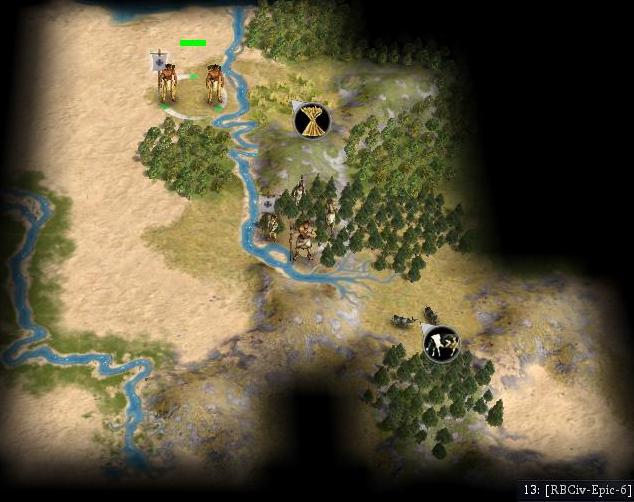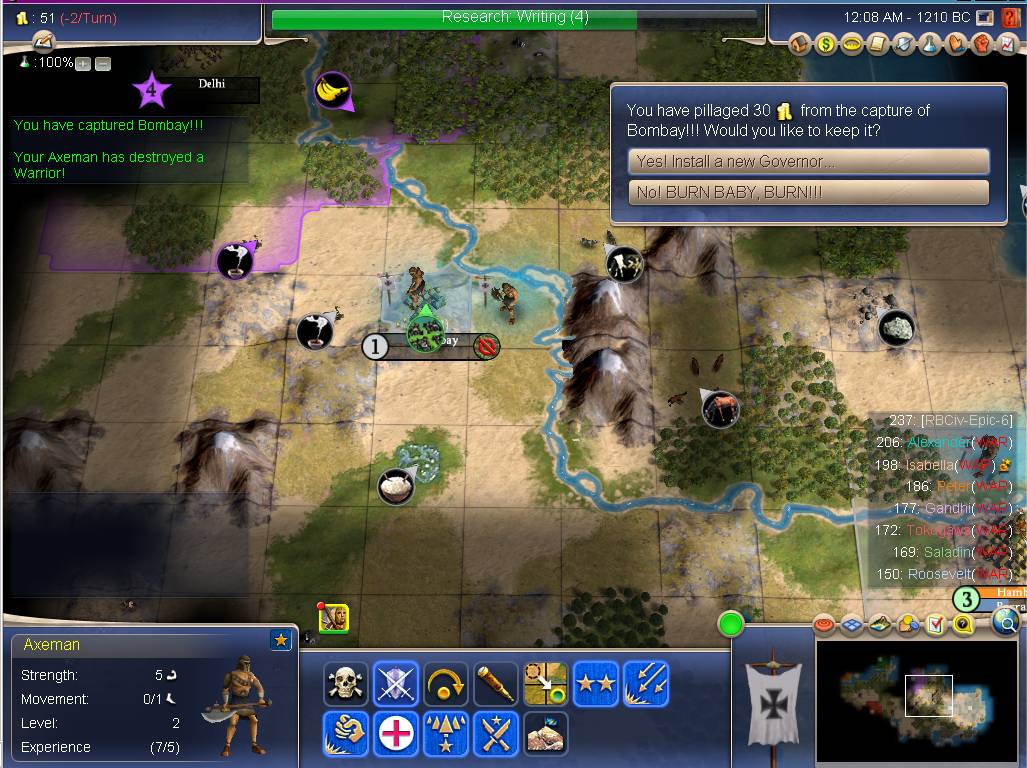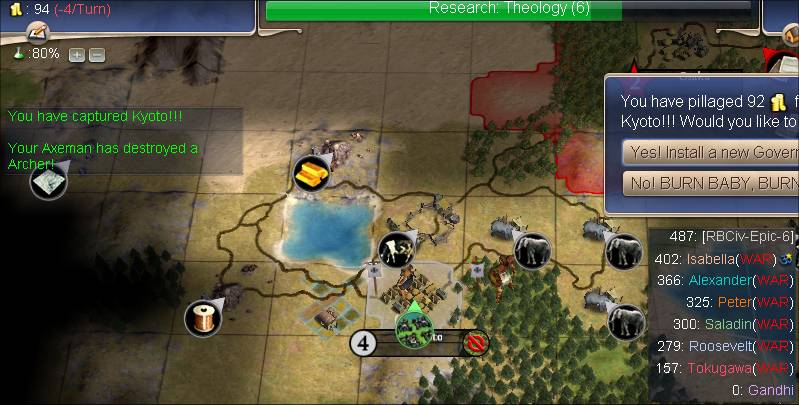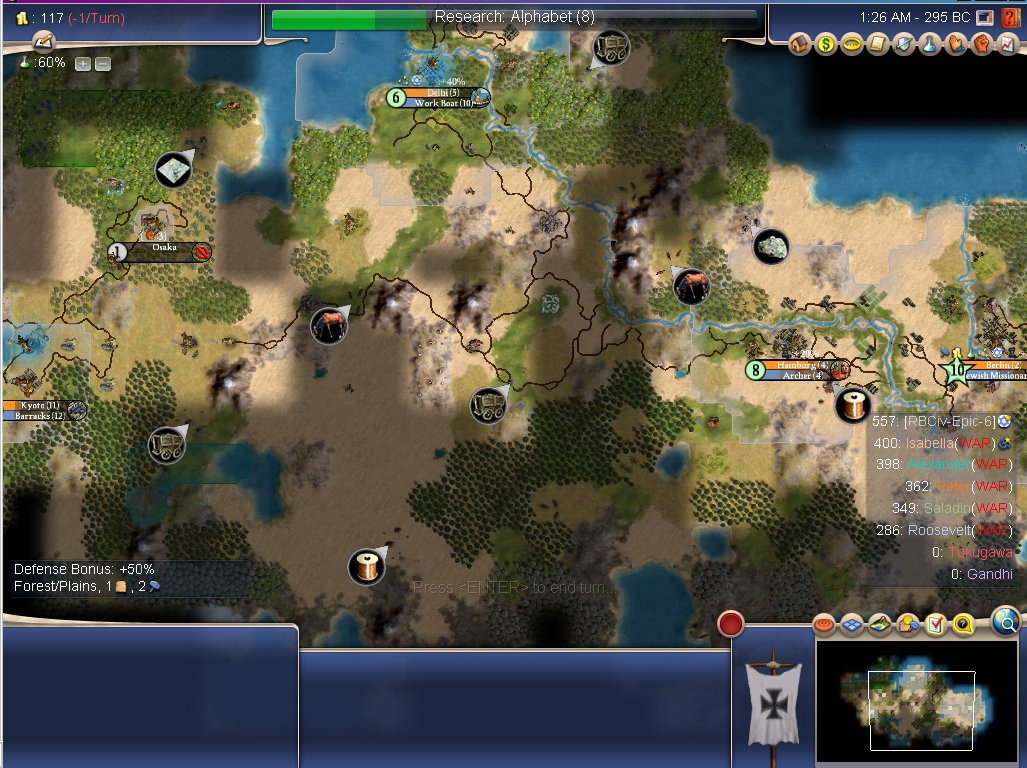
I founded on the starting square.
No barbarians, eh? I'll gamble that Sirian gave us some breathing room from the closest opponents, as he's done in every other Always War game. I went for a worker first, researching Agriculture. My scout explored out in a clockwise circle, intending to just explore one ring of territory then return home, but contacted an Indian warrior in 3730 BC. Swapped off worker to warrior, and ordered up Archery next, then Bronze Working. Finished the worker after the warrior (though the rival warriors didn't wander anywhere near my capital), then an archer.
We did indeed have copper nearby. Animal Husbandry ordered up as it's a shame to waste that cow. Started barracks while growing up to size, shelved it when city reached the happy cap at size 6 and started a settler. The Wheel next, then Pottery.
I boldly double-whipped the settler as two enemy scouts wandered towards the capital. Here's the city of Hamburg, obviously founded to claim the copper. And my warrior lost attacking a wandering scout at 95.6% odds, documented in the event log there for all to see.

Even though the cities weren't on the same river, they counted as connected by trade route, since that one square (where my archer is) is on both rivers so they're linked in the same trade group.
After the barracks, I built a second worker while the first mined and roaded the copper. My idea was to work on other things until the copper got hooked up -- to spend the fewest shields possible on inefficient (non-axeman) military units.
Both cities whipped granaries ASAP (we're Expansive), though Berlin actually did it by double-whipping an axeman and letting the overflow go onto the granary. Double-whips are better because you get more shields for the same unhappiness, but an Expansive leader actually can't double-whip a granary except by doing it from scratch and thus only getting one whip's worth of shields.
Iron Working came in, and Iron was right there in Berlin's radius. Nice.
My first two axemen set out towards Delhi, and ran into and over Bombay on the way.

Enemy City Captured in 1210 BC.
After Iron Working, there were a myriad of tech choices. OK, really, two. I could beeline Feudalism for Vassalage and longbows (going through Hereditary Rule and Organized Religion on the way), or Construction for catapults. I decided on the Feudalism beeline, since axemen are so strong that you really don't need catapults until enemy longbows appear.
By the time my first pair of axemen got to Delhi, there were three archers in the city, so they waited for my next pair of axemen. Just as my stack of four gathered to attack the city, Gandhi sent out a settler with one of the archers.

So I captured the city, losing three of my axemen (the fourth killed both damaged archers; he took two promotions to heal himself after the first one.) And the city came with a worker. It also came with Judaism, which would spread itself back to my home cities (Delhi's on the same river as Hamburg) and become my state religion.
And you can see Gandhi's score of 0 in the inset. I didn't yet realize I'd eliminated him, though -- I saw that settler leave Delhi, so was waiting for it to build a city somewhere. It never did, so I'm guessing that losing a civilization's last city eliminates it in Civ 4, regardless of wandering settlers. So Enemy Civilization Eliminated in 955 BC.
I apologize for the scarcity of detailed notes on my opening plays, but as I said, I hadn't planned to make a full report. I just beelined for axemen and for Delhi, and that worked out well enough.
After Monarchy, I actually reversed course to go for Theology instead of Feudalism. Theocracy seems like a better civic than Vassalage to get the extra +2 unit experience, since it comes at the cost of the highly tradeoffy Org Rel, while Vassalage would come at the cost of the mighty Bureaucracy.
Berlin and Hamburg started producing swordsmen to join the axemen. My stack collected itself and, after razing one fledgling Japanese city with only warriors, advanced on Kyoto:

The city had had one more archer in it before I advanced my stack into position, but it toked a joint and left the city before I attacked. Five units against two is a slaughter. I had a swordsman go first against the archer (at 63% but it lost), so that the CR3 axeman could take its +50% vs melee against that spear.

I kept the city with the intention of grooming it into an awesome military factory. The copper, elephants, and cow all provide hammers, plus two plains hills.
Meanwhile, Berlin had such a huge food surplus that even heavy whipping couldn't keep up with the population growth. Whipping 2 or 3 population at once is the most efficient in terms of happiness penalty per hammer produced. But if the city grows that back in sooner than 15 turns, the unhappiness penalty will pile up if you whip again, so eventually you really can't whip any more.
So I tried a tack that I'd read about but had yet to try for myself. I used that surplus food to run two scientists in Berlin for the sole purpose of popping a Great Scientist to build the city's Academy. The effect on my GNP was sizable, going from about 65 to 80 beakers civ-wide, and would only increase as Berlin grew up to size and its cottages matured.
With Hereditary Rule, and our Expansive trait, and our six workers we'd accumulated between training and capturing, it was now time to have the cities grow _upwards_. When Kyoto came out of resistance, my maintenance costs were 23/turn (ouch!) and my research rate was down to 60%.
I researched Theology, and founded Christianity (first time I ever have), and it picked Kyoto as its holy city. Not optimal, as now I'd have to run a Jewish missionary over here to get it in line with our state religion of Judaism.

Then I conquered the last Japanese city, which did pose a bit of a dilemma. The distance maintenance costs would be astronomical, but the city's got MARBLE, and I'd quite like the Great Library. Also I want both of the Epics quite soon, which both also use Marble. So possibly against my better judgment, I kept Osaka. Strangely enough, the game said its distance maintenance was only 4/turn, as opposed to 6/turn for the closer Delhi.
